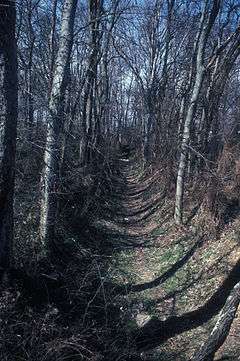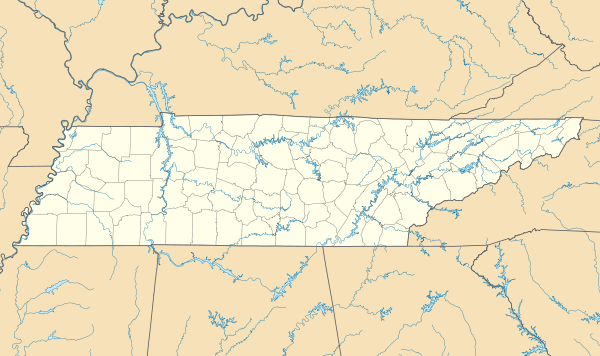Fort Granger
|
Fort Granger | |
 | |
  | |
| Location | Off Liberty Pike, Franklin, Tennessee |
|---|---|
| Coordinates | 35°55′33″N 86°51′38″W / 35.92583°N 86.86056°WCoordinates: 35°55′33″N 86°51′38″W / 35.92583°N 86.86056°W |
| Area | 20 acres (8.1 ha) |
| Built | 1862 |
| NRHP Reference # | 73001858[1] |
| Added to NRHP | January 8, 1973 |
Fort Granger is a property in Franklin, Tennessee that is now a City of Franklin park, in the central Franklin area.[2] It was part of American Civil War fortifications of Franklin and includes trenches dug by Civil War soldiers.
The Union Army captured Nashville early in 1862 and occupied Franklin within a few weeks.[3] The troops occupying Franklin were under the command of Maj. Gen. Gordon Granger, for whom the fort is named.[4] The Union Army, fearful of local unrest and Confederate guerrillas, began planning and construction for an artillery position that would protect the Nashville railroad line nearby.[5] Construction began in 1863 and was overseen by Capt. W. E. Morrill.[4] The fort was to be located on Figuer's Bluff, just north of the Harpeth River and parallel to the railroad to Nashville.[6] The fort was built on Figuer's Bluff because the bluff had military control over the Harpeth River bridge of the Tennessee and Alabama Railroad and it had control over the southern and northern approaches to Franklin.[7] The completed fort incorporated nearly 275,000 square feet.[6] The fort is approximately 781 feet long and 346 wide.[8] Until the Battle of Franklin, the fort was only occupied by a small garrison.[6]
The entrance to the fort was called the 'Sally Port.'[7] The strongest part of the fortification, called 'The Cavalier,' was the location where the ground was the highest.[9] This 'fort within a fort' was meant for times of overpowering attacks where defenders could make a final stand against invaders.[9] The Cavalier was ideal for artillery because it provided the best view of the surrounding landscape.[9]
The Union army hanged two Confederate spies at the fort on June 9, 1863.[6] The artillery in the fort was utilized twice in 1863 against Confederate cavalry forces.[4]
In September 1864, Confederate Gen. John Bell Hood led the Army of Tennessee against Union Gen. William T. Sherman's supply lines after Sherman defeated Hood at Atlanta.[10] Hood directed the army north into Tennessee.[10] Union General John M. Schofield slowed Hood at Columbia and Spring Hill before falling back to Franklin.[10] Guns from Fort Granger provided an enfilading fire upon Confederate attack in the Battle of Franklin on November 30, 1864.[11] The commanding Union general, John M. Schofield, spent most of his time during the battle in Fort Granger.[6]
The Confederate Army was subject to massed fire from the Union artillery in the fort.[12] Four 3-inch rifled cannons in Fort Granger were fired by Capt. Giles J. Cockerill, Battery D, 1st Ohio Light Artillery.[10] The Confederates suffered serious casualties to the 163 rounds fired by Cockerill’s guns.[10] The right wing of the Confederate line, commanded by Gen. A. P. Stewart’s Corps suffered the most from these rounds,[10]
A 20-acre (8.1 ha) area of the property, including one contributing structure and one contributing site, was listed on the National Register of Historic Places in 1973.[1]
There is a boardwalk on the southern side of the fort that leads to a trail, eventually connecting to Pinkerton Park.[2]
Roper's Knob Fortifications is another NRHP-listed fortification on the Franklin battlefield area.
See also
- Franklin Battlefield
- Winstead Hill, also NRHP-listed within the Franklin Battlefield area
- Carnton, also NRHP-listed in the battlefield
- Fountain Carter House, also NRHP-listed in the battlefield
References
- 1 2 National Park Service (2009-03-13). "National Register Information System". National Register of Historic Places. National Park Service.
- 1 2 "Fort Granger". www.franklin-gov.com. Retrieved 10 July 2016.
- ↑ Smith, Michael Thomas (2014). The 1864 Franklin-Nashville Campaign: The Finishing Stroke. Santa Barbara: Praeger. p. 7. ISBN 978-0-313-39234-4.
- 1 2 3 "Fort Granger". Historical marker, 113 Fort Granger Dr, Franklin, TN 37064
- ↑ Holladay, Bob (Spring 2009). "James Hogan, Jr., and the Conflicts of Antebellum Southern Identity in Williamson County". Tennessee Historical Quarterly: 20–39.
- 1 2 3 4 5 Jacobson, pp. 208-12; Welcher, p. 593; Sword, p. 167; Eicher, p. 772.
- 1 2 "Battlefield Tours Fort Granger". Civil War Landscapes. December 26, 2010. Retrieved March 24, 2015.
- ↑ McNutt, Kraig W. (2014). Who Built Fort Granger?. The Center for the Study of the Civil War.
- 1 2 3 "The Cavalier". Civil War Journeys. Retrieved 24 March 2015.
- 1 2 3 4 5 6 Dover, Michael (March 24, 2011). "The Historical Marker Database". The Historical Marker Database. Retrieved March 24, 2015.
- ↑ Jacob Dolson Cox (1897). The Battle of Franklin, Tennessee, November 30, 1864: a monograph. New York: C. Scribner's Sons. p. 123. Retrieved 10 July 2016.
- ↑ Crownover, Sims (December 1955). "The Battle of Franklin". Tennessee Historical Quarterly.
External links
- Fort Granger - City of Franklin